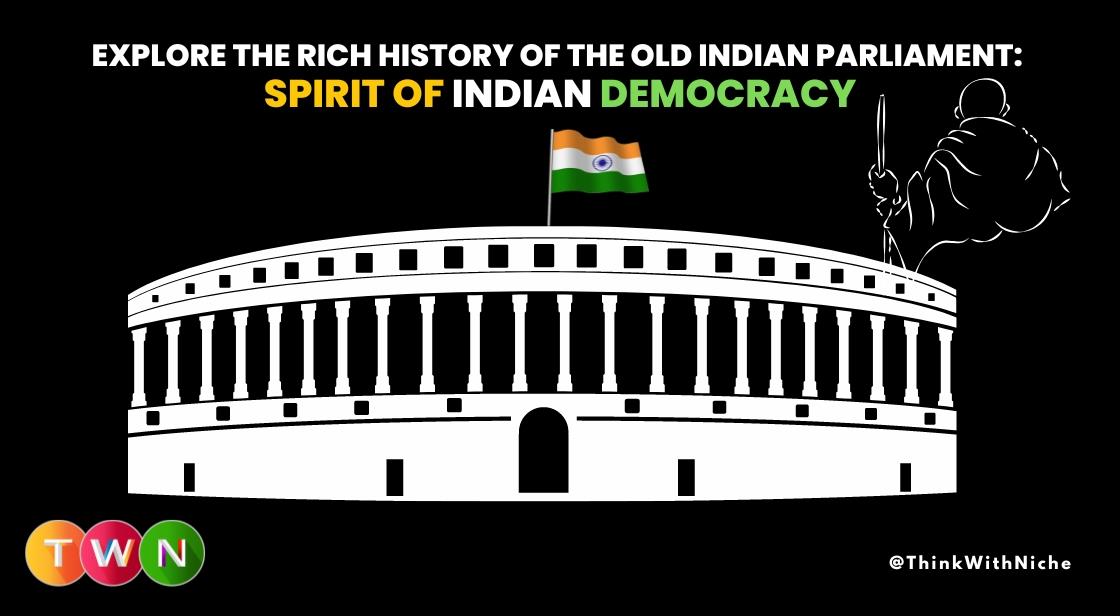Explore The Rich History Of The Old Indian Parliament: Spirit Of Indian Democracy

Blog Post
Let's go back in time and embark on a fascinating journey through the rich history of our old Indian Parliament, which played a pivotal role in shaping India's democratic journey.
Start with its inauguration in 1927 and understand the remarkable moments, enduring legacy, and significance of the then symbol of independence, the result of the struggle of crores of Indians, and the framing of the Constitution of India, which led to the construction of the new Parliament House.
The old Indian Parliament with its historic speeches, debates, and symbolic significance embodied the spirit of Indian democracy during the freedom struggle and the journey to independence. It stood as a beacon of hope, unity, and the collective will of the Indian people to carve their own destiny.
Today, while a new Parliament building takes center stage, the legacy of the old Indian Parliament lives on in the hearts of the Indian people as a symbol of democratic aspirations and perseverance.
Today, as we remember the indomitable spirit of our martyred freedom fighters and the emblematic sacrifice of those patriots who laid down their lives to liberate Mother India from the clutches of oppression, our hearts are filled with profound reverence for the soul of democracy.
We cherish the timeless legacy of our revered "first parliament," now referred to as the old parliament. In its hallowed halls, we find a testament to our unwavering self-respect and an enduring symbol of our cherished heritage.
This evokes an overwhelming sense of emotion, shared by every Indian who holds dear the values of liberty, justice, and unity.
However, as we tread the path of progress, it is imperative for us to embrace change in accordance with the evolving needs of our time. It is essential to foster a conscious and progressive society that is attuned to the demands of the present era.
In this context, the advent of the new parliament signifies not only a beacon of hope for the promising future of generations to come but also a transformative paradigm for nation-building.
It bestows upon us the power and fortitude to shape a brighter destiny, infused with strength, resilience, and the unwavering determination to chart a prosperous course for our beloved nation.
But the old Indian Parliament will forever be etched in history as a testament to the power of democracy and the collective voice of the Indian people.
The old Indian Parliament stands as a testament to India's democratic progress and the evolution of its governance. From its humble beginnings as the Central Legislative Assembly to its role as the venue for the Constituent Assembly's constitution-making process, this iconic institution holds a significant place in the nation's history.
With its grand inauguration in 1927, the old Parliament building became the cornerstone of democratic deliberations, witnessing the debates, discussions, and decision-making processes that shaped the nation's laws and policies.
It served as the meeting place for the Lok Sabha and Rajya Sabha, where elected representatives worked tirelessly to uphold democratic values and represent the aspirations of the Indian people.
History of the Old Indian Parliament
The history of the old Indian Parliament is a testament to the evolution of democracy and governance in the country. Over the years, this iconic institution has played a pivotal role in shaping the nation's political landscape and upholding democratic values.
Let's delve into the fascinating journey of the old Indian Parliament.
Early Days and the Central Legislative Assembly:
The foundation of the Indian parliamentary system can be traced back to the Central Legislative Assembly, which was established in 1919 under the Montagu-Chelmsford Reforms. This legislative body served as the precursor to the Indian Parliament and consisted of elected and nominated representatives.
The Constituent Assembly and the Making of a Constitution:
After India gained independence in 1947, the Constituent Assembly was tasked with drafting the country's Constitution. The old Parliament building, located in New Delhi, became the venue for this historic endeavor.
From 1946 to 1949, the Constituent Assembly members meticulously deliberated and framed the Constitution, which laid the foundation for a sovereign, socialist, secular, and democratic India.
With independence on the horizon, the Constituent Assembly gathered within the walls of the old Parliament building to shape India's future. Visionary leaders like Jawaharlal Nehru, B.R. Ambedkar, and others deliberated and debated, crafting the Indian Constitution, which laid the foundation for a sovereign, socialist, secular, and democratic republic.
The establishment of the Central Legislative Assembly in 1919 marked an important milestone in India's fight for self-governance. The old Parliament building served as a platform for Indian leaders to raise their voices, demanding greater political representation and a say in the governance of their own country.
Inauguration of the Old Parliament Building:
The old Indian Parliament building, a magnificent architectural marvel located in the heart of the national capital, New Delhi, was inaugurated in 1927. It stands as a testament to the country's commitment to democracy and its remarkable progress over the years. Designed by renowned architect Sir Edwin Lutyens, the building is an embodiment of India's aspirations for independence and self-governance.
The old Parliament building, an architectural marvel, was inaugurated by the then Governor-General of India, Lord Irwin. Designed by British architects Edwin Lutyens and Herbert Baker, the structure showcased a blend of Indian and Western architectural styles. Its imposing facade, with its iconic circular shape and grand colonnades, stood as a symbol of the nation's democratic ethos.
Historic Speeches and Debates:
The old Indian Parliament echoed impassioned speeches, debates, and discussions that galvanized the freedom struggle and shaped the course of India's independence. It became a platform where leaders such as Mahatma Gandhi, Jawaharlal Nehru, Sardar Vallabhbhai Patel, and others delivered powerful speeches, articulating the aspirations of the Indian people and rallying them towards the common goal of freedom.
Gathering Point for National Movements:
The old Parliament building served as a gathering point for various national movements and campaigns during the freedom struggle. From the Non-Cooperation Movement and the Civil Disobedience Movement to the Quit India Movement, it witnessed the mobilization of the masses and the determination of the Indian people to overthrow colonial rule and establish an independent nation.
Functioning of the Old Indian Parliament:
The old Parliament served as the hub of India's legislative activities for several decades. The two houses of Parliament, the Lok Sabha (House of the People) and the Rajya Sabha (Council of States), convened within its walls. Members of Parliament (MPs) engaged in debates, discussions, and decision-making processes, shaping the laws and policies of the nation.
Notable Moments and Historical Significance:
Throughout its history, the old Indian Parliament witnessed several defining moments that shaped the country's trajectory. From heated debates on crucial legislations to the election of the first Prime Minister, the building stood witness to India's democratic progress.
It also hosted notable events such as the silver jubilee celebrations of India's independence in 1972 and the golden jubilee celebrations in 1997.
The old Parliament building witnessed several symbolic moments of resistance and protest. Whether it was the Dandi March led by Mahatma Gandhi, where salt laws were defied, or the historic "Tryst with Destiny" speech by Jawaharlal Nehru, delivered on the eve of independence, these moments resonated with the spirit of Indian democracy and the relentless pursuit of freedom.
Representation and Inclusivity:
The old Parliament building symbolized the democratic values of inclusivity and representation. It provided a platform for diverse voices, representing different regions, religions, and backgrounds, to come together and contribute to the nation's decision-making process. This inclusivity strengthened the spirit of Indian democracy, emphasizing the importance of unity amidst diversity.
Transition to Independence:
As India approached its long-awaited independence, the old Parliament building became a space of anticipation and hope. It hosted historic sessions and meetings where leaders discussed the future governance of the nation, making crucial decisions that would shape the destiny of millions.
Transition to the New Parliament Building:
As India continued to grow and evolve, the need for a modern and more spacious Parliament building became evident. The decision to construct a new Parliament building was made, aiming to accommodate the growing number of legislators and provide state-of-the-art facilities. This transition marked the end of an era for the old Parliament building, which had been an integral part of India's political history for nearly a century.
Legacy and Remembrance:
While the old Indian Parliament building no longer serves as the center of legislative activities, its legacy and historical significance endure. It remains a symbol of India's democratic ideals, showcasing the nation's journey from colonial rule to an independent, vibrant democracy.
The memories and contributions of the MPs who walked its halls and chambers will forever be etched in the annals of Indian history.
As the baton is passed to the new Parliament building, the old structure will continue to hold a special place in the hearts of the Indian people, reminding them of the democratic principles and values on which their nation stands.
Preserving the Heritage:
While the old Parliament Building no longer serves as the primary legislative venue, efforts are underway to preserve its heritage and historical significance. It stands as a testament to the country's democratic ideals and the tireless efforts of countless individuals who have contributed to India's democratic evolution.
Embracing a New Era:
As the new Parliament building takes center stage, it embodies India's forward-looking vision and commitment to a dynamic and inclusive democracy. With its modern infrastructure and advanced technological capabilities, the new building is poised to support the evolving needs of lawmakers and enhance the efficiency of parliamentary proceedings.
From its inauguration in 1927 to its integral role in shaping India's democratic journey, the old Parliament building holds a special place in the nation's history.
It represents the spirit of democracy, fostering dialogue, and fostering progress. As India marches ahead, the transition to the new Parliament building marks a significant milestone, embodying the nation's aspirations for a brighter and more inclusive future.
The old Indian Parliament, with its distinctive features, holds a special place in the country's architectural and political landscape. Let's explore the exceptional characteristics that made it an iconic symbol of India's democracy.
Also Read: Dr. Bhimrao Ambedkar: A Warrior For Social Justice And Equality In India
Exceptional characteristics of the old Indian Parliament:
1. Architectural Splendor:
Designed by renowned British architects Edwin Lutyens and Herbert Baker, the old Parliament building showcased an exquisite blend of Indian and Western architectural styles. Its grand colonnades, imposing circular shape, and intricately carved facades reflected the magnificence and grandeur befitting a parliamentary institution.
2. Central Dome:
The highlight of the old Parliament building was its central dome, which served as a prominent focal point. The dome, adorned with intricate details and decorative elements, symbolized the spirit of democracy and unity that permeated the institution.
3. Assembly Halls:
The old Parliament building housed two important assembly halls: the Lok Sabha (House of the People) and the Rajya Sabha (Council of States). These spacious halls provided a dignified setting for members of Parliament to engage in debates, discussions, and legislative processes.
4. Historic Central Hall:
The Central Hall of the old Parliament building held immense historical significance. This majestic space witnessed the gathering of the Constituent Assembly, where momentous decisions were made, including the adoption of the Indian Constitution. The Central Hall was a symbol of unity and played host to significant events such as the presidential address on Republic Day.
5. Symbolic Statues:
The old Parliament building featured statues and symbols that represented India's rich cultural and political heritage. The premises were adorned with statues of eminent national leaders, including Mahatma Gandhi, B.R. Ambedkar, and Jawaharlal Nehru, paying tribute to their contributions to the nation.
6. Historical Artifacts:
Inside the old Parliament building, historical artifacts and artworks were displayed, showcasing India's rich history and cultural diversity. These artifacts served as a constant reminder of the nation's heritage and the values cherished by its people.
7. Historical Library:
The old Parliament building housed a distinguished library that served as a repository of knowledge and information. The library contained a vast collection of books, documents, and parliamentary records, facilitating research and providing valuable resources for lawmakers and scholars.
8. Symbol of Democracy:
The old Parliament building embodied the spirit of Indian democracy. Its iconic presence in the heart of New Delhi represented the democratic principles and values that guided the nation. It served as a beacon of hope, symbolizing the power of people's voices and their ability to shape the destiny of the nation.
The old Indian Parliament, with its architectural magnificence, historic significance, and symbolic value, left an indelible impression on the collective consciousness of the Indian people. While the building may have transitioned to a new era, its exceptional features continue to inspire and remind us of the enduring legacy of India's democratic ideals.
During the Indian freedom struggle and the journey towards independence, the old Indian Parliament stood as a powerful symbol of the nation's unwavering spirit of democracy. Let's delve into the highlights of its rich history within the context of India's struggle for freedom.
Think With Niche Editorial Conclusion: A Legacy of Democracy and Progress
Throughout its existence, the old Parliament building bore witness to pivotal moments that left an indelible mark on India's democratic fabric. From the election of the first Prime Minister to landmark legislations and historic celebrations, it stood as a symbol of India's commitment to democratic governance.
As India continued to grow and embrace the future, the need for a more spacious and modern Parliament building became evident. The transition to the new Parliament building marked the end of an era for the old structure, which had played a central role in the nation's political history for nearly a century.
Nevertheless, the legacy and memories of the old Indian Parliament will endure. It will forever be remembered as a beacon of democracy, representing the nation's journey from colonial rule to an independent, vibrant democracy. The contributions and efforts of the MPs who graced its halls and chambers will be eternally cherished.
As the baton is passed to the new Parliament building, the old structure will continue to hold a special place in the hearts of the Indian people. It will serve as a reminder of the democratic principles and values on which their nation was built and inspire future generations to uphold the spirit of democracy, progress, and unity.
You May Like
EDITOR’S CHOICE












